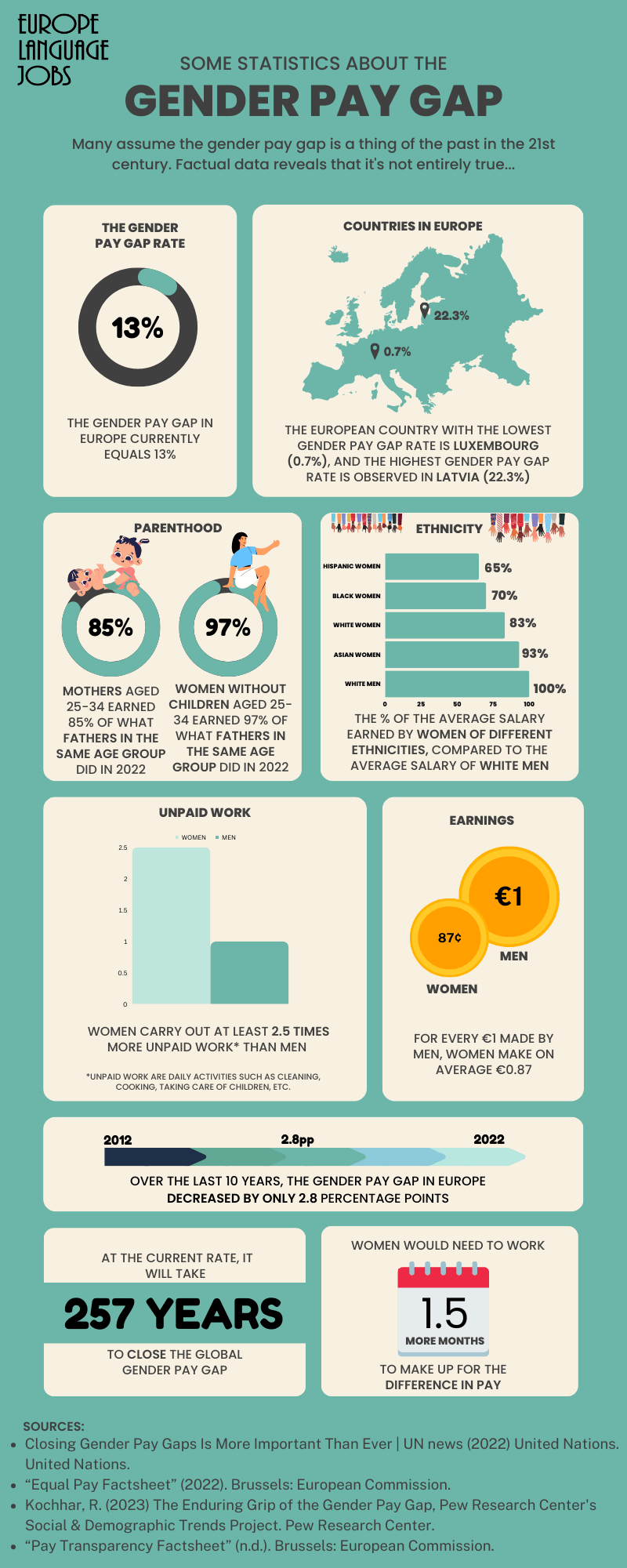As common as the term “gender pay gap” is, it is equally mysterious. We often question whether the phenomenon still exists in the 21st century. After all, we have come a long way regarding gender equality and fighting discrimination.
Certain legislatures are in place in order to ensure equal pay between men and women. How would it be possible, then, for the gender pay gap to still exist?
On International Women’s Day in 2023, we take a closer look at this issue. We have analysed data from a range of independent sources from within and outside of Europe to establish whether we can safely assume equal pay is a norm in today’s society.
So, does the gender pay gap still exist? Let’s find out.
1. What is being done to reduce the gender pay gap in Europe?
2. Direct vs. indirect discrimination
3. Gender pay gap affected by various criteria
4. Reasons behind the gender pay gap
What is being done to reduce the gender pay gap in Europe?
Addressing the gender pay gap and identifying its causes is one of the main objectives of the European Commission’s Gender Equality Strategy for 2020-2025. Therefore, various steps are being taken in order to first recognise, and then address and fight the existence of the pay gap in the European job market.
In March 2021, the EU Commission presented the Pay Transparency Proposal. Its main aim is to oblige European employers to reveal the data about pay levels for employees performing the same work, disclose salary information for job seekers, and report instances where the gender pay gap may occur.
As part of this effort, employers may also be required to generate pay stubs that provide clear information about employees' earnings and any discrepancies that may contribute to pay inequality.
Such information should be made public, easily available, and provided to an employee upon request with no objection from the employer.
A recent survey carried out by Eurobarometer revealed that almost â…” of Europeans support the idea of publishing the average salaries earned by employees of a particular company by gender and job type. However, it is worth noting that while an employer needs to comply with the regulations of the Pay Transparency Proposal, they will never be obliged to reveal the exact salaries of their individual employees.
The European Court of Justice has also provided an official definition for the term “work of equal value”. It does not necessarily mean performing the exact same job, for example comparing the salary of a female and male architect.
Work of equal value means different types of jobs where the educational, professional, and training requirements, skills, effort, responsibility, work undertaken and the nature of the tasks involved are equivalent.
For example, in the UK, it is officially recognised that lower-paid shop staff jobs, mostly performed by women, can be considered of equal value to higher-paid warehouse worker professions, predominantly carried out by men.
Additionally, the Work-Life Balance Directive introduced by the European Commission partly focuses on improving the gender balance in managerial roles. It will set the goal of a minimum of 40% of non-executive members of the under-represented gender on company boards.
Improvement in this area has already been noted, with 40% of managerial occupations being held by women in 2022, compared to only 26% 40 years earlier, in 1982. However, this number can still be improved, so initiatives such as the Work-Life Balance Directive are crucial.
Direct vs indirect pay discrimination
Before we discuss different factors affecting the disparities in pay for men and women, let’s understand the fundamental difference between the two types of discrimination: direct and indirect.
How is it possible that the gender pay gap still exists with so many legal regulations clearly stating that men and women must receive equal pay for performing equal work?
The devil, as usual, is in the detail.
Direct pay discrimination - someone receives less money because of their gender.
Indirect pay discrimination - a seemingly neutral reason puts representatives of a certain gender at a disadvantage, indirectly influencing their pay.
An example can be an instance where employers offer lower hourly wages for part-time workers than for full-time workers, when the part-time sector is heavily dominated by women.
The issue of the gender pay gap usually results from indirect pay discrimination. The law prevents employers from justifying lower pay just on the basis of gender, but numerous loopholes make it possible for disparities in pay to exist.
Therefore, while it is uncommon to observe a woman earning a lower salary than a man for the same profession, the differences in the type of employment, types of jobs, and the impact of unpaid work and household duties on professional life will indirectly result in differences in pay.
Gender pay gap affected by various criteria
The gender pay gap is a very complex phenomenon. Multiple factors are involved, impacting its severity. Discussing them all as a whole would be a generalisation, so we will address the most essential ones individually.
2. Occupation
3. Earnings
4. Education
6. Age
Types of employment
The data concerning the gender pay gap can vary greatly depending on the type of employment we’re looking at. In 2022, the gender gap in pay among full-time employees equalled 8.3%. It’s an increase of 0.6% percentage points, compared to 7.7% in 2021. Despite the slight raise, there is still an improvement from the time prior to the global pandemic, when the gender pay gap in the UK has reached 9% in 2019.
The gender pay gap for part-time employees reduced from -3% in 2021 to -2.8% in 2022. It is the highest among all employees because women occupy more part-time positions, which offer lower hourly wages than full-time positions. The gender pay gap among all employees remained relatively stable between 2021 and 2022 (15.1% to 14.9%), but remains lower than that of 2019, which equalled 17.4%.
Occupation
The British Office for National Statistics identifies 9 main occupation groups. They are:
-
Managers, directors, and senior officials
-
Professional occupations
-
Associate, professional and technical occupations
-
Skilled trades occupations
-
Administrative and secretarial occupations
-
Process plant and machine operatives
-
Sales and customer service occupations
-
Caring, leisure, and other service occupations
-
Elementary occupations
The gender pay gap is noted across all of these occupation groups, but has decreased in the past 3 years in all except 2: associate, professional and technical occupations, and skilled trades occupations. The former has noted an increase from 11% in 2019 to 12.1% in 2022, while the latter raised from 4.9% in 2019 to 6.2% in 2022.
The largest decrease could be observed in managers, directors and senior officials (down 5.7 percentage points from 16.3% to 10.6%) and administrative and secretarial occupations (down 4.1 percentage points from 22.3% to 18.2%). This means that women hold increasingly more managerial roles.
Earnings
As seen in the previous point, the most notable decrease in the gender pay gap was noted in the managers, directors and senior officials sector. This is because this occupation group receives one of the highest median pay levels of £23.25/hour for full-time employees, compared to the £16.30 for all full-time jobs, which makes the differences more visible.
Still, the disparity in remuneration by gender grows the higher we climb up the earnings ladder. 90th percentile employees are those who earn more than 90% of employees, but less than the remaining 10%. It is a group situated very high up the earnings ladder, sitting near the top.
In this group, male employees earn significantly more than equivalent female employees. The gender pay gap here equals 15.5% for full-time employees.
For comparison, this number among median earners equals 8.3%, and 3% for the bottom 10% of earners.
Education
The statistics concerning the impact of education on the gender pay gap are confusing.
Ironically, the gender pay gap is smaller among employees without a degree than those who completed a Bachelor’s or Master’s course, according to the Pew Research Center.
The source has gathered data from 1982 until 2022 and compared the role education played in the issue of the gender pay gap over these 40 years. The results are surprising.
Women with a high school diploma in 1982 earned 62% of what men did, while they now earn 83% relative to men with the same level of education (2022).
Interestingly, women with a higher education degree who earned 69% of what men did 40 years ago, now earn only 10 percentage points more, at 79%.
This means that the gender pay gap is actually lower for employees with a high school education than for those with a university degree.
There is also no correlation between the number of employed men vs women with a degree and the gender pay gap. 40 years ago, fewer women than men aged 25 and older had a university degree (20% vs 26%).
In 2022, the tables are turned. 48% of employed women have a higher education degree, compared to the 41% of men. Still, the gender pay gap closed more significantly in the two decades between 1982 and 2002 than it did in the past 20 years, between 2002 and 2022.
Race and ethnicity
The Pew Research Center demonstrated that in 2022, White women earned 83% of what White men did. This number equalled 70% for Black women, and 65% for Hispanic women.
The gender pay gap was the smallest for Asian women, whose earnings were 93% of those of White men. The gap in this group narrowed by 17 percentage points between 2002 and 2022, but there is no data available for the 2 decades prior to that period, until 1982.
A decrease in the gender pay gap was observed for women of all ethnicities between 1982 and 2022. However, said decrease was more significant for White women than for Black and Hispanic women.
Age
The British Office for National Statistics points out that analysis across age groups provides the clearest insights into the gender pay gap.
Different sources agree that the gender pay gap is the lowest for groups aged under 40. The ONS places it at 3.2% or below, as has been the case since 2017.
The Pew Research Center provides similar data, with women aged 25 to 34 earning about 92% of what men of the same age did in 2022. This number lowers for the group of women aged 35 to 44 and 45 to 54 standing at 83%, and drops even more, to 79% for women aged 55 to 64. This has been the general pattern for at least 40 years.
According to ONS, the gender pay gap for women aged 40-49 employed on a full-time basis stands at 10.9%. This is explained by a lower number of women advancing into higher-paid managerial roles after the age of 39, when the pay for these occupations increases.
When comparing 2022 to 2021, the gender pay gap for employees aged 22-29 decreased by 0.2pp, 0.8pp for those aged 30-39, and 1.9pp for those aged 60 and above.
However, when we take into consideration the passing of time, the numbers seem less optimistic. Women who fell in the age group of 25 to 34 in 2010 earned 92% of what men of the same age did, compared to the 83% of women overall. Now, when they are aged 37 to 46, they earn only 84% of what men their age do.
Having children
The disparities in pay according to age can be better understood when we compare them with the age at which men and women are most likely to have young children.
In 2022, the group that most commonly reported having at least one child (66%) was employed women aged 35 to 44. This number dropped to 40% among female employees aged 25 to 34, 39% for the age group of 45 to 54, and 6% for those aged 55 to 64.
The highest number of male employees with children also reaches its peak in the age group of 35-44, standing at 58% in 2022. It is common for fathers in this age group to receive the highest salaries, while the pay of mothers in the same group remains unaffected.
Mothers aged 35 to 44 earned 80% of what fathers within the same age group did in 2022. This number increased to 85% for mothers aged 25 to 34. For comparison, women in that same age group without children earned 97% as much as fathers of the same age that year.
Interestingly, mothers aged 45 to 54 enjoy a higher pay than women that age with no children. When it comes to men, those with no children in the age groups of 35 to 44 and 45 to 54 earned only 84% of what men their age who were fathers did.
The fact of having children also affects the number of women looking for a job and being professionally active. In 2022, 84% of childless women aged 25 to 34 were looking for a job, compared to 70% of job-seeking mothers of the same age.
In order to help you visualise the numbers, this translates to 1.4 million young mothers withdrawing from the workforce after having children.
In contrast, men within the same age group who are fathers are more likely to have a job or look for one than those without children.This may suggest that the gender stereotypes of mothers leaving their jobs to take care of their children and fathers being the breadwinners persists in our society.
In the age group of 35 to 44, 75% of mothers are active in the workforce, compared to 94% of fathers. 78% of women and 84% of men without children within the same age group are professionally active.
The disparity can be clearly seen when we look at the gap between those numbers. Only 6 percentage points divide the number of childless men and women who are active members of the workforce, in comparison with the 19 percentage points for mothers and fathers of the same age.
Fathers also tend to spend more time at work than their male colleagues without children. Mothers, on the other hand, opt for a working week shorter by 2h on average than that of the childless women their age.
Career advancement
We have already established that earnings are often strictly tied to the level and position one occupies. 21% of women claim to be a boss or hold a top managerial role in their workplace, compared to 28% of men. 35% of those men are fathers.
Interestingly 46% of women surveyed by the Pew Research Center said they are currently not a boss and don’t hold a top managerial role, but they also don’t want to. When it comes to men, 37% of them agreed with that statement.
The number of men and women who say they are currently not in charge but would like to be one day is almost even for both genders, although it’s a little bit higher for women. 35% of female employees wish to reach the top of the professional ladder, compared to 31% of their male colleagues.
Reasons behind the gender pay gap
The Pew Research Center carried out a survey where they asked participants about the main reasons for the existence of the gender pay gap. The responses noted were heavily influenced by gender, marital and family status, and even political views.
The 3 top causes of the gender pay gap named in the survey were:
-
Women are treated differently by employers
-
Women tend to make different choices about balancing work and family than men
-
Women tend to work in jobs that pay less
The most notable takeaways from the survey are that women are much more likely than men to acknowledge the fact that employers treat female employees differently than their male counterparts as the main reason behind the gender pay gap. 61% of women believe it to be the main cause, with only 37% of men agreeing with them.
The choices that women make about balancing family and work life were interestingly appointed as a crucial reason behind the pay gap by parents with young children (48%) more commonly than people without children (40%).
Country case studies
Some countries are doing more than others to eradicate the gender pay gap. According to the 2020 data by the European Commission, the lowest gap in Europe could be observed in Luxembourg (0.7%), and the highest in Latvia (22.3%). For comparison, the average for all of the EU States is 13%.
Here are some other countries which also deserve recognition in terms of actions taken to fight the gender pay gap:
-
Iceland - companies with more than 25 employees are obliged to obtain a certification proving they provide equal pay for work of equal value for all genders.
-
France - businesses with more than 50 employees have to create an action plan to ensure gender equality and are sanctioned if they don’t do it.
-
Poland - a free app was launched by the government which helps employers monitor the pay gap in their companies.
To conclude, the gender pay gap does exist, and is closing rather slowly. The United Nations estimate that at the current rate, it will take 257 years for the global gender pay gap to close completely.
As thrilling as celebrating the International Women’s Day in 2280 by announcing the gender pay gap is officially a ghost of the past would be, it would be even better if we didn’t have to wait so long.
The first step to eradicating the problem is understanding the root of it. Ignorance is bliss, but assuming that the issue cannot possibly exist because it’s illegal doesn’t make it go away.
So many factors contribute to the persistence of the difference in pay for men and women, and we hope we have shed some light on the most crucial ones.
Employers can - and should - take action to make sure these loopholes are not taken advantage of in their businesses. Individuals may contribute by acknowledging the issue, speaking up, and taking advantage of such measures as the Pay Transparency Proposal, which equips them with the right to access real data about equality - or the lack of it - in pay.
Equal work deserves equal remuneration, and we all have the power and the obligation to fight for it - regardless of our gender.
Sources:
-
Aragão, C. (2023) Gender Pay Gap in U.S. Hasn't Changed Much in Two Decades, Pew Research Center. Pew Research Center. (Accessed: March 8, 2023).
-
Closing Gender Pay Gaps Is More Important Than Ever | UN news (2022) United Nations. United Nations. (Accessed: March 8, 2023).
-
“Equal Pay Factsheet” (2022). Brussels: European Commission.
-
Gender Pay Gap in the UK: 2022 (2022) Gender pay gap in the UK - Office for National Statistics. Office for National Statistics (ONS). (Accessed: March 8, 2023).
-
Kochhar, R. (2023) The Enduring Grip of the Gender Pay Gap, Pew Research Center's Social & Demographic Trends Project. Pew Research Center. (Accessed: March 8, 2023).
-
“Pay Transparency Factsheet” (n.d.). Brussels: European Commission.
-
Samega, J. and Kollar, M. (2022) Income in the United States: 2021, United States Census Bureau. (Accessed: March 8, 2023).
Feeling inspired? Visit our blog for more career advice! How can you be sure the information we provide is top-notch? We are a group of professionals working with recruiters, career coaches, and HR specialists from all over the world!
Trust our experience and let us help you find a new job in Europe!
























Sofia Hofmann10mo ago
Wage gaps shouldn't exist in the first place. Men do not provide more intelligence than woman. Manpower maybe but nowadays even that is discussable. Woman are discovering their own power more than ever and that needs to be talked about. It's time for change!
Wage gaps shouldn't exist in the first place. Men do not provide more intelligence than woman. Manpower maybe but nowadays even that is discussable. Woman are discovering their own power more than ever and that needs to be talked about. It's time for change!